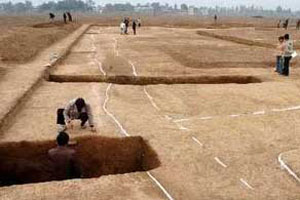| Tools: Save | Print | E-mail | Most Read |
| China's Earliest Handicraft Workshop Discovered? |
| Adjust font size: |
One of the world's oldest handicraft workshops, dating back more than 3,600 years, may have been discovered by Chinese archaeologists in the country's Henan Province. Covering about 1,000 square meters the workshop used turquoise to make elaborate and ornate works of art. The workshop was found in the village of Erlitou of Yanshi City and is part of the ruins of the imperial city belonging to the Xia dynasty (2100 BC-1600 BC), China's earliest. The imperial city was discovered two years ago. At the workshop crafts people made ornaments with inlaid turquoise, said Xu Hong, head of the team of archaeologists studying the site. Xu and his colleagues, from the Archaeological Research Institute of the Chinese Academy of Sciences, excavated the area after they found scraps of turquoise in a pit in 2004. The workshop was likely used for at least 200 years. Xu said that they also found ruins of a wall around the workshop which was across a road from the imperial city. "This shows that the workshop was used to serve the imperial family judging from its close location to the imperial city," observed Xu. In 2002 archaeologists discovered a 70-cm-long turquoise dragon formed with more than 2,000 pieces of turquoise of various shapes in the ruins of the palace. "Probably, the turquoise dragon was made at this workshop," Xu said. Chinese archaeologists dubbed the artifacts the "Dragon of China" saying it was the earliest evidence of the Chinese fascination with dragons. In ancient Chinese legends dragons had a scaly body and a pair of horns. They could walk, fly and swim and had magical powers which could raise wind and make rain. For Chinese people the dragon is a symbol of fortune and wisdom and is the intermediary by whom humans communicate with god and other mysterious beings. For thousands of years the Chinese have regarded themselves as the "descendants of the dragon." Large quantities of raw materials, roughcast and semi-finished products were found in the workshop making it possible for archaeologists to study the original techniques used to make turquoise wares and ornaments, said Xu. Analysis of turquoise workshop would help archaeologists identify the means of production, provide evidence on the location of mines and inform them of the social structure of the time, added the expert. The recent discoveries of the turquoise workshop together with a bronze casting workshop, the foundations of large palace buildings, a network of roads and city walls, provided significant evidence proving the ancient people of Erlitou were sophisticated urban planners, Xu said.
(Xinhua News Agency August 9, 2006) |
| Tools: Save | Print | E-mail | Most Read |
 |
| Related Stories |
| Product Directory China Search |
Country Search Hot Buys |

